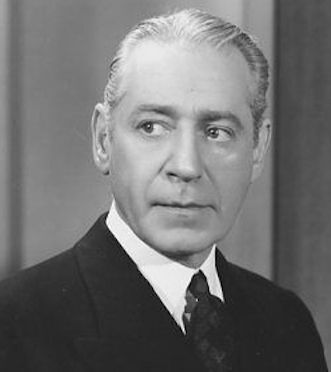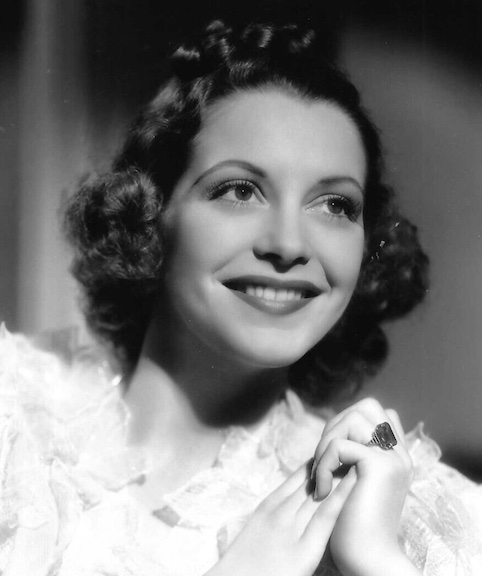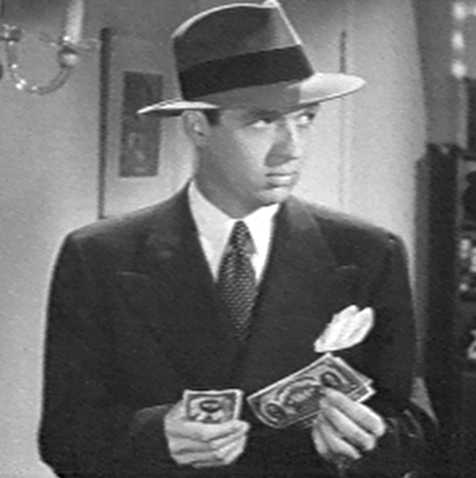Features:
 The average movie fan might not know Henry
O’Neill by name, but his face is familiar: he appeared in well
over 100 films. He appears in both of Laurel & Hardy’s
wartime comedies for M-G-M, Air Raid Wardens
and Nothing but Trouble.
The average movie fan might not know Henry
O’Neill by name, but his face is familiar: he appeared in well
over 100 films. He appears in both of Laurel & Hardy’s
wartime comedies for M-G-M, Air Raid Wardens
and Nothing but Trouble.Henry
O’Neill was born in Orange, New Jersey on August 10, 1891,
and like many character actors he had a wealth of stage
experience. He appeared in such hit plays as Conquest,
The Last Mile, and Seventh Heaven before
being recruited for the new talking pictures. His first film
was a Warner Vitaphone short called The Strong Arm
(1930), which was also Spencer Tracy’s first film. During
the Depression years Warner made movies fast and often, so
O’Neill got valuable on-camera experience (and exposure) in
dozens of Warner features. He can be seen in all types of
films, from the musical Footlight Parade to
the thriller The Walking Dead.
O’Neill’s
screen characters were usually “men of distinction” —
tycoons, judges, bankers, attorneys, doctors, military
officers, society leaders. A small coterie of character
actors specialized in these roles (Russell Hicks, Samuel S.
Hinds, Pierre Watkin, Selmer Jackson, Charles Trowbridge,
etc.) and they were popular enough to freelance at various
studios. Henry O’Neill could easily have pursued a freelance
career, but in late 1940 he left Warner Bros. to accept a
contract with Hollywood’s most prestigious studio,
Metro-Goldwyn-Mayer. His restrained demeanor and prosperous
appearance were perfect for M-G-M’s dignified, glossy
productions. Among his notable M-G-M films: Shadow of
the Thin Man, Girl Crazy, Red
Skelton’s comedy-mysteries Whistling in the Dark
and Whistling in Brooklyn, and the Laurel
& Hardy features Air Raid Wardens (as the
leader of a spy ring) and Nothing but Trouble
(as the host of a disastrous dinner party). One of Henry
O’Neill’s most familiar scenes, frequently seen in
anthologies, was almost literally a throwaway: in the
coming-attractions trailer for The Big Store,
O’Neill announced to the world that the Marx Brothers were
leaving motion pictures.
M-G-M’s
“family” of employees usually stayed with the company for
many years — until 1948, when M-G-M and other studios were
forced to divest their nationwide theater chains. Hundreds
of employees were let go, in the face of reduced production
and the rising popularity of television. O’Neill lost his
berth at M-G-M but didn't lose any ground; other studios
used his services until the late 1950s. He died on May 18,
1961, at the age of 69.
Henry O’Neill was never a scene-stealer like other character actors, but his quiet professionalism was an important ingredient in his two Laurel & Hardy pictures.
Copyright © 2025
by Scott MacGillivray.
 The supporting casts in Laurel
& Hardy pictures of the 1930s were usually drawn from a
resident stock company of comedians. In the 1940s, however,
the larger studios assigned their own promising actors, who
gained valuable experience and larger roles in these
moderately budgeted films. A few went on to stardom (Alan
Ladd, Robert Mitchum, Vivian Blaine, Stephen McNally).
Perhaps the prime beneficiary of this showcasing was Arthur
Space. His prominent role in The Big Noise
was probably the largest of his career.
The supporting casts in Laurel
& Hardy pictures of the 1930s were usually drawn from a
resident stock company of comedians. In the 1940s, however,
the larger studios assigned their own promising actors, who
gained valuable experience and larger roles in these
moderately budgeted films. A few went on to stardom (Alan
Ladd, Robert Mitchum, Vivian Blaine, Stephen McNally).
Perhaps the prime beneficiary of this showcasing was Arthur
Space. His prominent role in The Big Noise
was probably the largest of his career.
Arthur Space was born on October 12, 1908 in New Brunswick, New Jersey. In 1937 he became an actor on the legitimate stage, and played a gangster in the audience-participation courtroom drama The Night of January 16th. In 1941 Edward Finney, a veteran movie producer and director, took a chance on the slim, pencil-mustached actor. Arthur Space played a gangster’s henchman in Finney’s low-budget melodrama Riot Squad, released by Monogram. Space’s stage presence and confident voice got him noticed. He jumped from the humble Monogram to the plush M-G-M, where he worked as a contract player for the next two years. Comedy fans may remember seeing him in Abbott & Costello’s Rio Rita as a saboteur posing as an upstanding citizen. Space was frequently loaned out to other studios to play small-town professionals, shifty crooks, or both. The 20th Century-Fox crime drama Quiet Please, Murder cast Space as a hoodlum posing as a police detective. These dual roles showed casting directors how versatile Space could be, and he began playing larger character roles.
In 1943 he was given a role in Laurel & Hardy’s The Dancing Masters (as their boss), but all of his scenes were cut for time reasons. Meanwhile he continued to build “a reputation as one of the best bit players in Hollywood,” to quote Fox publicists. In 1944 he was assigned to the studio’s next Laurel & Hardy comedy, The Big Noise, in which he gives a memorable performance. His “inventor” characterization has some eccentric qualities and even some light romantic overtones, unlike many of the straightforward character parts Space usually had.
Arthur Space continued to play small roles in big pictures, and big roles in small pictures. He often worked without screen credit. In the late ’40s and early ’50s he could usually be found at M-G-M, Columbia, Monogram, or Republic, playing small-town citizens (Margaret O’Brien’s father in Her First Romance, a rural lawyer in The Bowery Boys’ Feudin’ Fools, a trucking-company official targeted for ruin in the serial Government Agents vs. Phantom Legion). His dignified bearing also landed him several military roles, and his performance in the Gene Autry western Last of the Pony Riders landed him frequent guest shots in Autry’s television productions.
As the Hollywood "B" movies began dying out, Space became increasingly busy in television, making guest appearances in other popular series (“Adventures of Superman,” “Perry Mason,” etc.). He also had a recurring role in the top-rated “Lassie” show (as a country doctor), and a leading role in the “National Velvet” series (appearing without his usual mustache, as Velvet’s father).
By the 1970s Arthur Space, now in his sixties, was still playing small roles in movies and television. His roles were limited in dramas of the ’70s, but he could play victimized senior citizens and grubby derelicts equally well. His last feature film was a personal project of actor-director Ralph Waite, star of “The Waltons.” Arthur Space was one of the very few veteran actors in the cast of On the Nickel, Waite’s 1980 portrait of skid row. Space became ill during his final months, and died of cancer in 1983. He was 74.
Arthur Space summed up his Laurel & Hardy assignments in a press release for The Big Noise: “Working with Babe and Stan is wonderful training for any actor, as an opportunity to watch the best timing and coordination in the business—but it’s plenty tough, too... The boys work together so well that one follows right along when the other throws in something new. As for me, I’m likely to plunge blindly into my next line and spoil the take.”
Copyright © 2024 by Scott MacGillivray.
 The career of a Hollywood ingenue
could be compared to that of an athlete. She may enjoy
several years of prominence, but she may not remain at the
top of her profession for more than a decade or so. One of
Laurel & Hardy’s co-stars not only outlasted many of her
contemporaries, but she had two flourishing screen
careers (and even dabbled in a third!) over three decades.
She appeared as a damsel in distress in Any Old Port,
and in the title role of The Bohemian Girl.
Laurel & Hardy fans know her as Jacqueline Wells.
The career of a Hollywood ingenue
could be compared to that of an athlete. She may enjoy
several years of prominence, but she may not remain at the
top of her profession for more than a decade or so. One of
Laurel & Hardy’s co-stars not only outlasted many of her
contemporaries, but she had two flourishing screen
careers (and even dabbled in a third!) over three decades.
She appeared as a damsel in distress in Any Old Port,
and in the title role of The Bohemian Girl.
Laurel & Hardy fans know her as Jacqueline Wells.
Born Jacqueline Brown on August 30, 1914 in Denver, Colorado, she was a promising juvenile actress who was featured in stage plays at the Pasadena Community Playhouse. This theater was regularly attended by movie talent scouts, and many actors at Pasadena received offers from the studios. Using the professional name of Jacqueline Wells, she worked in two-reel comedies at the Hal Roach studios during the 1931-32 season, with Laurel & Hardy, Charley Chase, and The Boy Friends.
Many novice screen actresses were first tried in westerns and serials as a practical screen test, to gauge their ability and appeal. Jacqueline Wells also went this route when Universal offered her a contract. She appeared in serials under the name of Diane Duval. This phase of her career didn’t last long, however, because casting directors began to take notice of Jacqueline Wells. One of her more prominent roles was in Monogram’s The Loud-Speaker (1934), as an actress trying to get along in New York. That same year she was named one of the “WAMPAS Baby Stars,” an annual selection of starlets considered by exhibitors as good bets for stardom.
The Bohemian Girl (1936), co-starring Jacqueline Wells, climaxed her freelance career. She then signed a contract with Columbia Pictures. Columbia made a few important films each year, but the backbone of its organization was a steady stream of “B” pictures and short subjects for neighborhood theaters. Wells was the ingenue in many of Columbia’s unpretentious but entertaining features like Paid to Dance and When G-Men Step In.
Most Columbia
contract players were called upon to appear in anything.
In order to gain valuable experience before the cameras,
they’d appear in a big feature film on Monday, a little
feature film on Tuesday, a serial on Wednesday, or a
two-reel comedy on Thursday. It was all in a day’s work for
Columbia’s stock company. The seasoned Jacqueline Wells
managed to steer clear of Columbia’s slapstick shorts but,
because she knew the ropes, she was sometimes recruited for
screen tests, to recite sample scenes opposite neophyte
actors. The hectic Columbia workplace kept her busy, but the
studio failed to promote her to bigger productions — while her Columbia
contemporary Rita Hayworth rose in prominence and got all
the attention. Wells finally left Columbia in 1939 to resume
freelancing. Jacqueline Wells’s last credit found her back
at Monogram in Her First Romance, starring
another former Columbia stalwart, Edith Fellows.
The actress, already concerned about her stagnating career, recognized that 10 years of hard work hadn’t made her a star. She left Hollywood and joined a repertory company in Wisconsin. “It was getting away from people who knew me that did it,” she recalled in a 1943 interview. “In the little stock company, I was a big shot because I hailed from Hollywood, and for the first time I was fussed over. My inferiority complex began to vanish and when I returned to Hollywood I had blood in my eye and fight in my heart.”
She auditioned for Warner Brothers with a new hairstyle and wardrobe, and claimed to be an actress from New York named Julie Bishop. Still in her twenties, she was young enough to play ingenues and was promoted as a new face. She was cast in Warner product for the next several years, and her more famous credits include Action in the North Atlantic and Rhapsody in Blue. During her vogue as a Warner star, her older films were reissued to cash in on her popularity, and her “Jacqueline Wells” billing was revised to read “Julie Bishop.”
“The girl I used to be is dead and buried,” she said. “Until I shed Jacqueline Wells, I was the girl Hollywood overlooked.”
In 1946 the major studios released many of their contract players, Julie Bishop among them. She found work almost immediately at the smaller, independent studios. In 1952 she landed the feminine lead in the Bob Cummings sitcom “My Hero,” and she continued to work in movies and TV through 1957. She also appeared in regional stage productions.
In private life the former Jacqueline Wells pursued a wide variety of personal interests in California. She was a prolific painter, a licensed pilot, and the president of a national scholarship association. On August 30, 2001 — her 87th birthday — she succumbed to pneumonia.
We applaud the
professionalism of this talented actress, “a rose by any other
name.”
Copyright © 2023 by Scott
MacGillivray.
 SECOND
EDITION, REVISED AND EXPANDED
SECOND
EDITION, REVISED AND EXPANDED
Laurel & Hardy: From the Forties Forward
by Scott MacGillivray
Scott MacGillivray’s Laurel & Hardy: From the Forties Forward was the first book to fully chronicle the later careers of Stan Laurel and Oliver Hardy, and everything that followed, from theatrical reissues to home videos. If you enjoyed the book the first time, you’ll like this new edition even more. The author has expanded the original text by more than 50 percent, to include new insights, new information, and new discoveries in Laurel & Hardy history, never before published. (Which Laurel & Hardy comedy of the 1940s was withheld from release for almost four years? Which “forties” movie was their all-time biggest hit? Which movie was almost shut down by federal intervention?) You’ll read much more about Stan and Ollie’s unrealized projects, including five more feature films, two TV series, and two Broadway shows. A must-read for Stan and Ollie’s fans everywhere, Laurel & Hardy: From the Forties Forward is better than ever!
